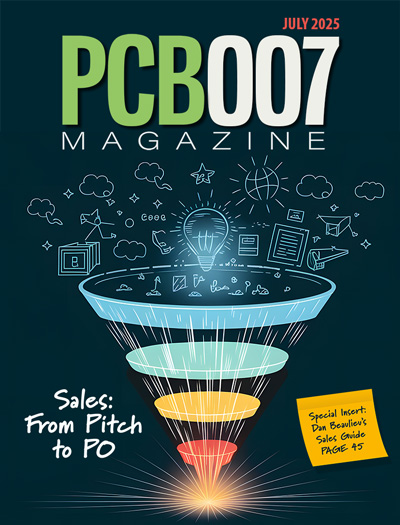-

- News
- Books
Featured Books
- pcb007 Magazine
Latest Issues
Current Issue
Advancing the Advanced Materials Discussion
Moore’s Law is no more, and the advanced material solutions to grapple with this reality are surprising, stunning, and perhaps a bit daunting. Buckle up for a dive into advanced materials and a glimpse into the next chapters of electronics manufacturing.

Inventing the Future With SEL
Two years after launching its state-of-the-art PCB facility, SEL shares lessons in vision, execution, and innovation, plus insights from industry icons and technology leaders shaping the future of PCB fabrication.

Sales: From Pitch to PO
From the first cold call to finally receiving that first purchase order, the July PCB007 Magazine breaks down some critical parts of the sales stack. To up your sales game, read on!
- Articles
- Columns
- Links
- Media kit
||| MENU - pcb007 Magazine
Estimated reading time: 2 minutes
FlexFactor: Faith in the Future
Take just a minute and read through this list of new product ideas. Can you identify the common thread? Yes, they are all enabled by advanced technology, but would you believe that these products were all pitched in the last year by high school students?
Drive Alert:
Problem – Drowsy driving.
Solution – A patch placed on the temple can detect if the user is drowsy and wakes up the user.
Technology – Circuits form a flexible patch with sensors detecting theta brain waves indicating if the user is drowsy or daydreaming.
Fast Asleep:
Problem – In 2015, there were nearly 4,000 Sudden Unexpected Infant Deaths (SUIDS) in the U.S., with 1,600 of those being attributed to Sudden Infant Death Syndrome (SIDS). Because of this, 59% of working parents do not get enough sleep.
Solution – A small wristband fits snugly around sleeping baby’s arm and measures movements, oxygen, and heart rate, to let you know the baby is safe and sound asleep.
Technology – Mounted flexible hybrid electronic wristband connected to device via Bluetooth.
RA Solutions:
Problem – RA is a chronic, inflammatory disease that causes mild to severe joint pain and stiffness, which can lead to a wide variety of damaged body systems including skin, eyes and lungs.
Solution – The Relieve Sleeve, a pain reliever that administers heating sensations and applies electric pulses tailored to a user’s needs. The functions are embedded in a compression sleeve for easy application around joints and muscles.
Technology – Flexible battery, micro-coiling embedded in the compression fabric, Bluetooth chip to connect to the app, electrical pulses produced from thin wires, wireless charging hub for battery.
Asthmex:
Problem – According to CDC, 25.7 million Americans suffer from asthma. Between the years 1996–2012, 8% of Olympic athletes suffered from asthma. 11.8% of the 7.8 million high school athletes in the U.S. have asthma.
Solution – A chest band with a smart patch to detect asthma symptoms, which triggers and administers medication via auto-injector.
Technology – Smart fibers within the band detect symptoms of an attack specific to the individual.
Just to reiterate, these creative new product ideas have all been pitched by high school students! These students have all participated in the NextFlex FlexFactor program. Growing the next generation of advanced manufacturing workforce is a key component of the NextFlex mission of developing technologies for commercial adoption while supporting a sustainable manufacturing ecosystem.
What is FlexFactor™?
This program is designed to enable youth to engage with next generation technology through entrepreneurial immersion. Over the course of this program, students work in teams to conceptualize a flexible hybrid (FHE) electronics-based hardware device that solves a human health issue or performance monitoring program, develop a business model around the opportunity, and pitch “Shark Tank” style to a panel of industry representatives. In the process, students become immersed in advanced technology and entrepreneurship, are inspired by the advanced manufacturing industry segment, and gain a deeper understanding of the education and career pathways for the future.
This four-week program kicks off in the classroom where students break into teams, are given the mission, the building blocks of flexible hybrid technology, and can define the problem and research hypothesis. Throughout the program, students interact with assigned technical mentors as they develop their product idea.
To read the full version of this column which appeared in the November 2017 issue of The PCB Magazine, click here.
More Columns from PCB Talk
PCB Talk: Is DWM Just Another Buzzword?PCB Talk: Burning Questions About Designing for SAP
PCB Talk: SAP—Changing the Way You Look at PCB Design
PCB Talk: SAP Evaluating From Design Perspective
PCB Talk: Creative Minds Pushing Boundaries
PCB Talk: Additive Electronics—Are You One of the Curious?
PCB Talk: Collaboration To Shorten the Learning Curve
PCB Talk: A Review of Additive Electronics


